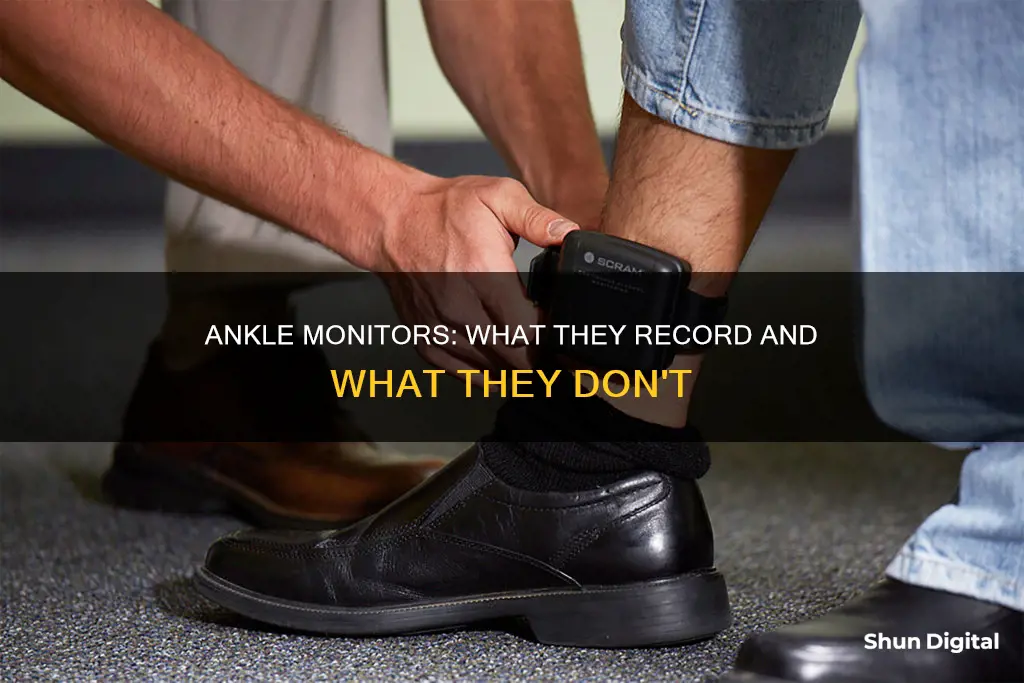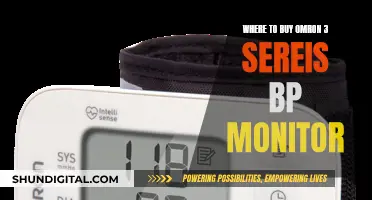
Ankle monitors are electronic devices worn by individuals who are under house arrest, on probation, or awaiting trial. They are commonly used as an alternative to incarceration, allowing individuals to continue their lives while complying with court orders. While the primary purpose of ankle monitors is to track an individual's location, there have been concerns about their potential to record conversations without consent. This raises questions about privacy and the potential violation of constitutional rights. Newer models of ankle monitors have microphones, enabling two-way communication between the wearer and law enforcement. However, the legality and ethical implications of this recording capability are still debated, with critics arguing that it invades privacy and may violate attorney-client confidentiality.
| Characteristics | Values |
|---|---|
| Purpose | Surveillance, monitoring, and tracking |
| Users | Defendants, people on probation or parole, undocumented immigrants, repeat offenders of drinking-related crimes |
| Features | GPS, two-way communication, speakers, microphones, alcohol consumption monitoring |
| Functions | Tracking location, notifying authorities of breaches, reminding wearers of court dates, charging devices, monitoring alcohol consumption |
| Privacy Concerns | Eavesdropping, recording without consent, third-party privacy rights, intrusion |
| Criticisms | Lack of secondary data checks, incorrect data, battery issues, interference with medical procedures, unclear data ownership |
What You'll Learn

Ankle monitors can record without consent
Ankle monitors are electronic devices fitted to individuals, commonly worn around the ankle, as an alternative to prison or jail. They are used to track the location of the wearer and ensure they are complying with court orders, such as house arrest or parole conditions. While the primary purpose of ankle monitors is location tracking, there have been concerns about their potential to record audio without the wearer's consent.
The inclusion of microphones in ankle monitors has sparked privacy and legal concerns. While not all ankle monitors have built-in microphones, the more sophisticated models do include this feature. The primary purpose of the microphone is to allow for remote voice identification, but there are worries that it could be used for eavesdropping. In certain states, such as Illinois and California, wiretapping laws prohibit the recording of conversations without the consent of all parties, which would make the use of microphones in ankle monitors illegal in these states.
The Track Group, a company that manufactures ankle monitors with two-way communication capabilities, claims that their devices are not used to violate the law. However, there have been reports of individuals receiving unexpected calls through their ankle monitors, raising concerns about the potential for invasion of privacy. The two-way communication features of these devices enable law enforcement to listen in on conversations at any time, which could potentially violate attorney-client confidentiality and the constitutional right to counsel.
Additionally, there are concerns about the ownership and access to the data collected by ankle monitors. While the law enforcement agency monitoring the individual has ownership rights to the data, other federal and state-level departments may also have access. The data is typically collected through third-party companies, who then have some rights to the information. The lack of clarity and regulations regarding data ownership further complicates the issue of consent and privacy.
While there have been no reported cases of ankle monitors being used to record conversations without consent, the potential for this to occur is a significant concern. The inclusion of microphones in ankle monitors has far-reaching implications for the privacy and legal rights of individuals, and it is essential that the use of this technology is carefully regulated to ensure it does not infringe on the rights of those who wear them.
Best Places to Buy Office Monitor Stands
You may want to see also

Ankle monitors can call without consent
Ankle monitors have become a common alternative to incarceration, with judges routinely ordering criminal defendants to wear them. These electronic monitoring devices are often used as a condition of bail or probation. While they are primarily used to track the location of the wearer, concerns have been raised about their potential to infringe on privacy and record conversations without consent.
The ReliAlert XC3, a GPS ankle monitor manufactured by the Track Group, has been at the centre of this controversy. In 2014, a technician testified in a case in Puerto Rico that the device's listening and speaking capabilities could be activated without warning. This means that calls can be initiated at any time, and there is no way for the wearer to decline or avoid being recorded. The device is supposed to play a three-note sound when an official call and recording begin, but the technician's testimony suggests that this may not always be the case.
The Track Group's devices are widely used in criminal justice systems across the United States, including in Cook County, Illinois, and Marion County, Indiana. In Cook County, the devices are used to monitor juveniles awaiting trial and some adult probationers, while in Marion County, they are used for people awaiting trial and those who have been convicted. The Track Group has refused to disclose the full list of jurisdictions where their monitors are deployed, citing potential competition concerns.
The ability of ankle monitors to record conversations without warning has sparked privacy concerns and debates about potential constitutional violations. Kate Weisburd, a professor at George Washington University Law School, argues that consent cannot be a blanket excuse for privacy invasions and that there must be some limits. The potential for these devices to record incriminating statements or private discussions with legal counsel has raised alarm among privacy advocates and defendants alike.
While there have been no reported cases of ankle monitors being abused in this manner, the mere possibility has sparked debates about the ethical and legal implications of such surveillance measures. The balance between public safety and individual privacy remains a delicate issue, and the use of ankle monitors that can record without consent continues to be a contentious topic.
Unlocking HP Monitor: Power Button Lock Removal Steps
You may want to see also

Ankle monitors can be used to track undocumented immigrants
The use of ankle monitors on undocumented immigrants has been a controversial topic. On the one hand, ankle monitors allow authorities to keep track of the whereabouts of undocumented individuals, ensuring they comply with the conditions of their release. This can be particularly useful for those who have been released from detention centres while awaiting deportation hearings or seeking asylum.
On the other hand, there are concerns about the potential invasion of privacy and infringement of rights. Some ankle monitors have built-in microphones that can be remotely activated, raising concerns about the potential for eavesdropping on private conversations. While the law prohibits using these microphones for anything other than voice identification, there are worries about the potential for abuse. Additionally, the physical and mental health impacts of wearing an ankle monitor for extended periods have been raised as a concern, with some reporting side effects such as aches, cramps, and anxiety.
The effectiveness of ankle monitors in preventing reoffending and reducing crime is also debated. While some studies suggest that electronic monitoring can reduce the likelihood of absconding and reoffending, others argue that it does not physically restrain individuals from leaving a certain area or committing crimes. The use of ankle monitors on undocumented immigrants remains a complex issue, balancing the need for surveillance with concerns for privacy, human rights, and physical and mental well-being.
New Sedans: Blind Spot Monitoring as a Standard Feature
You may want to see also

Ankle monitors can be used to monitor alcohol consumption
Ankle monitors are increasingly being used as a form of surveillance to monitor the location of individuals. These electronic devices are often fitted as a condition of bail or probation, but can also be used in healthcare and immigration settings.
Ankle monitors can also be used to monitor alcohol consumption. These devices are known as Secure Continuous Remote Alcohol Monitors, or SCRAMs. SCRAMs are often court-ordered for those convicted of driving under the influence (DUI), but they can also be used in other cases where alcohol use is a concern, such as family court, domestic violence cases, underage drinking, and substance abuse charges.
The SCRAM device works by monitoring the wearer's perspiration every 30 minutes. When a person consumes alcohol, a small amount is excreted through the skin in the form of insensible perspiration. The SCRAM device detects this alcohol at the surface of the skin and sends the data to a private company for analysis. If the wearer is found to have consumed alcohol, the company reports it to the court or probation department.
In addition to alcohol monitoring, SCRAM devices can also detect any tampering with the bracelet. If an offender attempts to remove or destroy the device, the monitoring company is immediately notified and can report it to the court or probation officer.
The use of SCRAMs has been shown to be effective in supporting long-term behavior change and reducing the risk of reoffending. However, there are also concerns about the potential invasion of privacy and the cost of these devices, which can be quite expensive for the wearer.
LCD Lifespan: Dark Themes' Impact on Screen Health
You may want to see also

Ankle monitors can be used to monitor health conditions
Ankle monitors have been used in the criminal justice system for several decades now, but their use in healthcare settings is a more recent development. While ankle monitors are typically associated with tracking the location of individuals, they can also be used to monitor health conditions. This technology has the potential to improve patient care and safety, particularly for those with dementia or other cognitive impairments.
In healthcare settings, ankle monitors can be used to monitor the location of patients, particularly those who may be at risk of wandering off and getting lost or injured. For example, in the case of patients with dementia, electronic monitoring may be used to prevent them from leaving the premises of a care facility or their homes. This can provide peace of mind for caregivers and family members, ensuring that patients are safe and can be located quickly if needed.
Additionally, ankle monitors can also be used to monitor other health conditions. For instance, Secure Continuous Remote Alcohol Monitoring (SCRAM) devices are ankle bracelets that monitor sweat samples for the presence of alcohol. These devices are often used for offenders who have committed alcohol-related crimes, but they could also be used in a healthcare context to support individuals struggling with alcohol addiction.
Another example is the use of ankle monitors to track physical activity and fitness. These devices can record steps taken, distance travelled, and even heart rate and sleep patterns. This information can be useful for individuals looking to improve their health and fitness levels, as well as for healthcare providers monitoring the progress of patients with certain medical conditions.
While the use of ankle monitors in healthcare settings offers several potential benefits, it has also sparked debates about patient privacy and human rights. Some critics argue that the use of electronic monitoring on psychiatric and dementia patients is demeaning and invasive. There are concerns about the potential for over-surveillance and the impact of monitoring on patient dignity and autonomy.
In conclusion, while ankle monitors have traditionally been associated with criminal justice and location tracking, their use in healthcare settings to monitor health conditions is an emerging trend. Ankle monitors have the potential to improve patient care and safety, particularly for individuals with cognitive impairments or those struggling with addictions. However, it is important to carefully consider the ethical implications and ensure that the use of such technology is proportional and minimally invasive.
Hooking Up Multiple Monitors to Your GeForce GTX 1080
You may want to see also
Frequently asked questions
Ankle monitors are a form of surveillance that can record a person's location via GPS. Some ankle monitors also have built-in microphones that can be used to record conversations without the wearer's consent. However, the use of microphones in ankle monitors is currently not standard, and there are legal restrictions on their use in some states.
The use of microphones in ankle monitors has raised concerns about potential violations of privacy and dignity, as well as rehabilitation. The ability of law enforcement to listen in on conversations without consent can be seen as an invasion of privacy, especially for conversations with attorneys, family, or employers. Additionally, the constant surveillance and intrusion into individuals' lives can lead to feelings of isolation and interference in their rehabilitation process.
Ankle monitors are electronic devices fitted to a person's ankle, commonly used during probation, pre-trial conditions, or as an alternative to detention. They transmit the wearer's location via GPS, allowing law enforcement to track their movements and ensure compliance with court orders. Ankle monitors can also be used to monitor alcohol consumption for repeat offenders of drinking-related crimes. In some cases, they may be used to track undocumented immigrants facing removal from a country.







